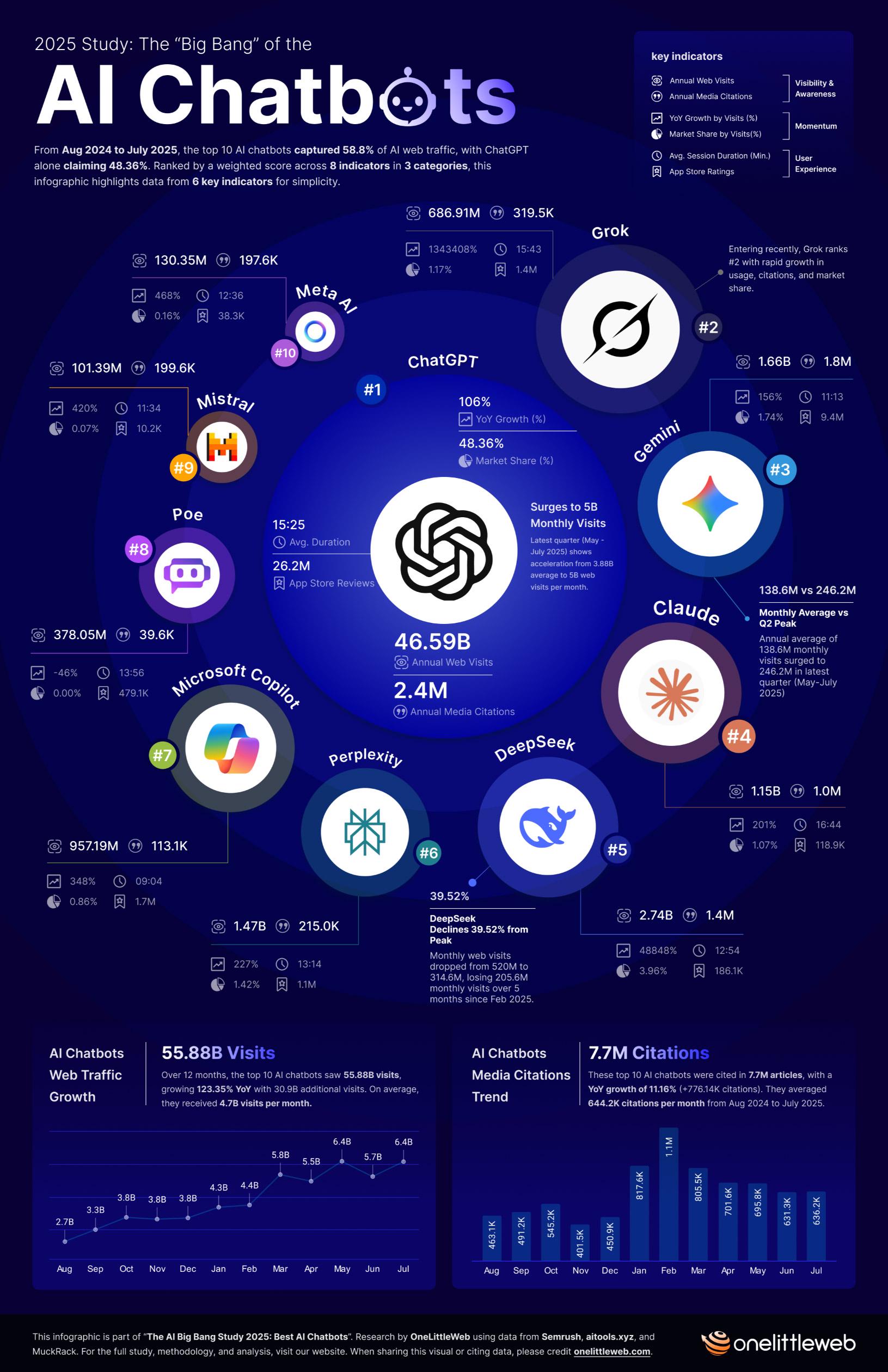The AI 'Big Bang' Study 2025 — Best AI Chatbots and What 55.88 Billion Visits Reveal Visualization

Data Analysis
What This Visualization Shows
This data visualization displays "The AI 'Big Bang' Study 2025 — Best AI Chatbots and What 55.88 Billion Visits Reveal" and provides a clear visual representation of the underlying data patterns and trends. The visualization focuses on This infographic from t[he AI 'Big Bang' Study 2025](https://onelittleweb.com/data-studies/best-ai-chatbots/) zooms in on the top 10 AI chatbots from August 2024 to July 2025 — ranked using 8 key performance indicators instead of just traffic numbers.
Over the past year, these chatbots collectively generated **55.88 billion visits**, accounting for **58.8% of all AI tool traffic**. The market saw **triple-digit growth** overall, with some platforms skyrocketing into the rankings while others declined sharply.
**Highlights from the study:**
* **#1 ChatGPT** — 46.59B visits, 48.36% market share, +106% YoY growth * **Fastest Riser:** Grok — +13,434,08% YoY growth to 686.9M visits * **Gemini** — +156% YoY growth, now at 1.66B visits * **Claude** — highest average usage time at 16:44 minutes/session * **DeepSeek** — peaked at 520.2M visits in Feb 2025, but declined 39.5% by July
The full study includes **20+ charts and visuals** showing traffic trends, market share shifts, and engagement patterns shaping the AI chatbot space in 2025., which allows us to understand complex relationships and insights within the data through visual storytelling.
Deep Dive into the Topic
Scientific data visualization is fundamental to modern research methodology, enabling researchers to explore complex datasets, identify patterns, and communicate findings effectively to both scientific and public audiences. This approach transforms abstract numerical data into comprehensible visual formats that reveal insights not apparent in raw data.
Research data often involves multiple variables, time series, and complex relationships that require sophisticated visualization techniques. Scientific visualizations can reveal correlations, outliers, and trends that guide hypothesis formation and experimental design. Medical research particularly benefits from data visualization for tracking treatment outcomes, understanding disease patterns, and presenting clinical trial results.
The impact of scientific data visualization extends beyond academic research. Public health officials use epidemiological visualizations to track disease outbreaks and plan interventions. Environmental scientists employ data visualization to communicate climate change impacts and conservation needs. Medical professionals use patient data visualizations to improve diagnosis accuracy and treatment planning. This broad application makes scientific data visualization a critical tool for evidence-based decision-making in research and practice.
Data Analysis and Insights
The patterns revealed in this visualization demonstrate the importance of systematic data analysis in understanding complex phenomena. By examining different data segments, time periods, and categorical breakdowns, we can identify trends that inform strategic planning and decision-making processes.
Statistical analysis of this data reveals variations across different dimensions that provide insights into underlying drivers and relationships. These patterns help identify areas of opportunity, potential risks, and key performance indicators that can guide future actions and resource allocation.
The analytical approach used in this visualization enables comparison across different categories, time periods, or geographic regions, revealing insights that support evidence-based decision-making. This type of analysis is essential for organizations seeking to optimize performance and understand complex market dynamics.
Significance and Applications
This data visualization has important implications for understanding trends and patterns that affect decision-making across multiple sectors. The insights derived from this analysis can inform policy development, business strategy, resource allocation, and operational improvements.
For analysts, researchers, and decision-makers, this type of data visualization provides essential insights for strategic planning and performance optimization. Whether addressing operational challenges, market analysis, or policy development, understanding data patterns helps create more effective strategies and solutions.
The broader significance lies in how this information contributes to our understanding of complex systems and relationships. This knowledge helps predict future trends, identify potential challenges, and develop more informed approaches to problem-solving and opportunity identification.
Comments
Loading comments...
Leave a Comment
About the Author

Alex Cartwright
Senior Data Visualization Expert
Alex Cartwright is a renowned data visualization specialist and infographic designer with over 15 years of experience in...